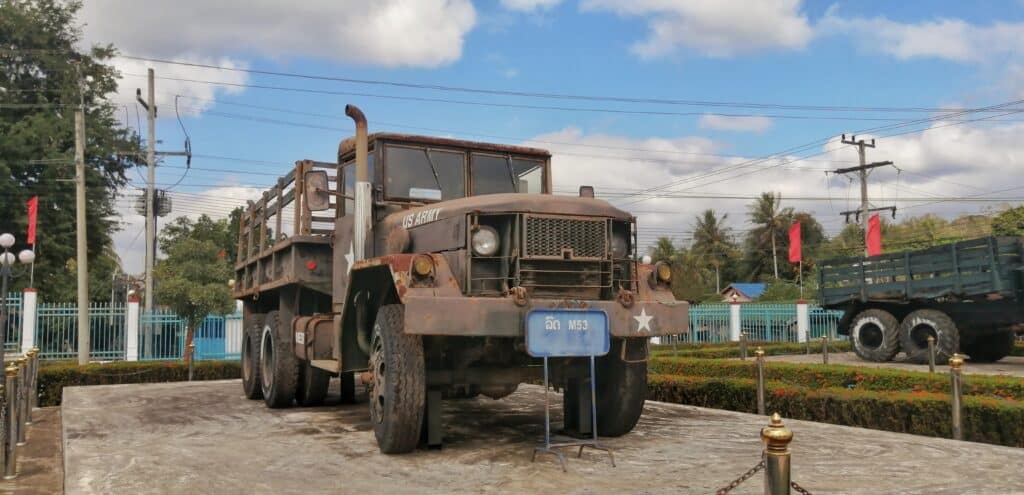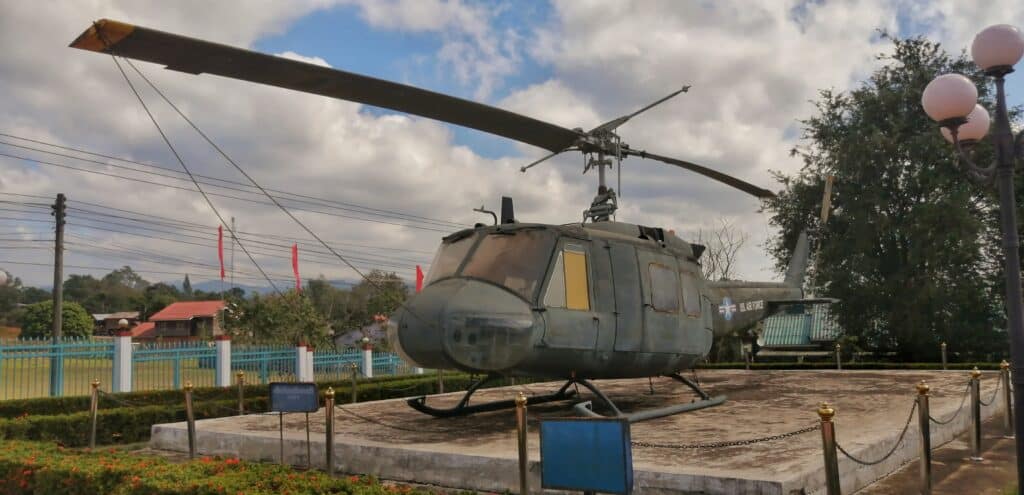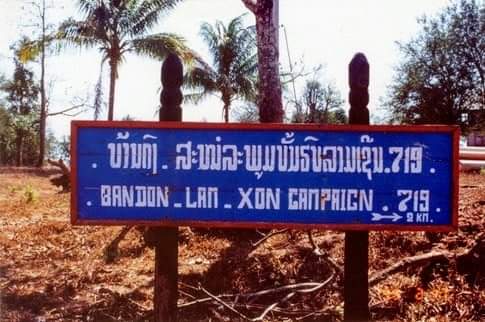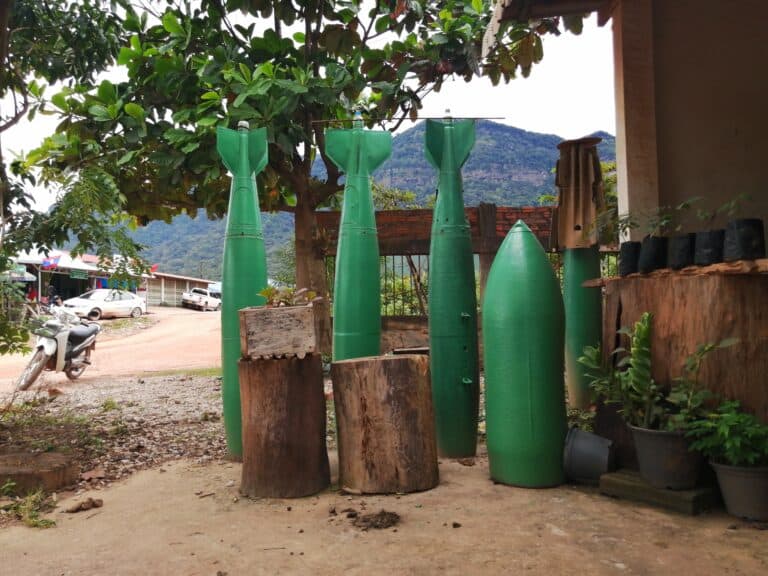Tales From The Ho Chi Minh Trail-Operation Lam Son 719 Museum
Operation Lam Son 719 Museum
Location: Ban Dong Savannkhet N16° 38.088′ E106° 25.739′
There is museum dedicated to the battle that took place in this area on Feb 8, 1971 – Mar 25, 1971. The South Vietnamese Army was to throw everything at this area to try to stop the flow of Arms into South Vietnam, down the Ho Chi Minh Trail.
The NVA where all over this area, they had Tunnels and Basecamps, either side of Route 9. The fact the NVA knew they we’re coming, and we’re well prepared for what lay ahead. Like many operations in Laos, the enemy always seemed to know well ahead, what was going to happen.
If your traveling down that way, it’s a good stop, with lots of information on display inside. Outside has some of the Tanks, Planes and Guns used in the Battle, some have been restored a little, but sitting in the weather is destroying them. A must if your into the trail and it’s History. There is plenty to see in the area, with some good riding too.







The Battle Field.

40th Anniversary: Laos to open Battle of Ban Dong war museum next yearPosted on September 8, 2010, by reedVientiane, Laos – Communist Laos is planning to open a museum to commemorate 1971’s Battle of Ban Dong, one of the pivotal clashes in the Indochina War, media reports said Wednesday.The Lao-Viet Commemorative War Museum, which cost 5 billion kip (625,000 dollars) to build, was due to open to the public next year in Dong village in Savannakhet province in southern Laos near the site of the battle, also called the Lamson 719 battle.The fighting pitted communist Lao and Vietnamese troops against the South Vietnamese army and its US allies. The confrontation lasted from February 8 to March 20, 1971, and ended in a resounding victory for the communist forces. It was seen as a turning point in the Indochina War, which eventually ended with a communist victory in 1975.“The Lamson 719 battle in Xepon district was one of many places in Laos that witnessed heavy conflict during the struggle against foreign aggressors,” said Bounauer Phomkhe, deputy director of the Savannakhet provincial Labour and Social Welfare Department.Bouauer told the Vientiane Times that the museum would display photos of the battle along with military equipment used by the Lao and Vietnamese forces.“Both our countries’ soldiers fought bravely and sacrificed their lives to protect their lands from US aggressors,” he said. background notes on the “Battle of Ban Dong”From Wikipedia, the free encyclopedia.The Battle of Ban Dong was a major battle of the Vietnam War that took place in Laos, involving the North and South Vietnamese armies. The battle lasted from February 8 to March 20, 1971.Before Operation Lam Son 719 began, intelligence indicates that North Vietnam had permanently placed logistical units in the Ban Dong area, especially along the Ho Chi Minh Trail. The logistical units were supported by one regular division, with another one ready for rapid deployment. In order to capture Tchepone, the district of Ban Dong had to be brought under South Vietnamese control.DiversionsThe initial objective of Lam Son 719 was to capture Ban Dong and the surrounding areas, establish firebases and then find and destroy the enemy. Once the first phase of the operation is completed, the 1st ARVN Infantry Division and its supporting units would move on Tchephone. Again, they would set up strong points, sweep the occupied areas and then find and destroy the enemy.In order to achieve their initial objectives, the Army of the Republic of Vietnam had a diversionary plan drawn up, the aim was to fool the North Vietnamese High Command in regards to South Vietnamese operations. During early February the 147th Marine Brigade, under the command of Colonel Hoang Tich Thong, was airlifted from Da Nang to Dong Ha. The arrival of a South Vietnamese brigade close to the DMZ created an impression that an assault was about to be launched against North Vietnam when the 147th Marines Brigade cross the Dong Ha river landing crafts in an amphibious exercise. The North Vietnamese Army reacted by attacking the South Vietnamese Marines violently.A few days later the 147th Marine Brigade was moved to Khe Sanh as the main ARVN force was preparing for the main operation.Ban DongOn February 8 President Nguyen Van Thieu gave the order to attack, with the 1st Airborne Brigade and the 1st Armour Brigade launching an attack on Ban Dong. Originally, the South Vietnamese Army planned to capture Ban Dong on February 9 but due to early miscalculations, Ban Dong was captured on February 12. With the help of combat engineers, Fire Support Bases A Luoi, 30 and 31 was immediately set up.Initially, the ARVN encountered little resistance, but reconnaissance activities noticed increasing activities of North Vietnamese troops in the area.On March 18, after heavy casualties were inflicted on the South Vietnamese on Hill 723, the joint North Vietnamese and Pathet Lao forces launched a counterattack supported by armor. After some hard fighting, FSB 30 and 31 were overrun. Pressure from the North Vietnamese anti-aircraft fire prevented South Vietnamese troops from being resupplied, as a result, ARVN morale collapsed.Taking advantage of the ARVN’s critical situation, the combined Communist forces launched a deep thrust into South Vietnamese defensive formations. After nearly three days of fighting, the South Vietnamese took more casualties as the 1st Paratroop Brigade was virtually wiped out by the North Vietnamese Army. Source; Reed.



I was there on the opening day, they asked us to leave, saying it was bad luck to have a foreigner on site. We left, since then they painted the tanks. There is plenty of interesting places to visit in the area. Ban Xepon Wat, Phu Tamok, NVA Tunnels and the Ban Raving Pass, to name a few, it’s great area to explore.




Lots more to see inside the Museum and the rest of the grounds. More to come 8/2/22
Enjoy this post? Find the rest of our Ho Chi Minh Trail Tales here. Interested in riding in Laos, but looking for more adventure in different areas of Laos, Check out our Laos ADV Tours page.







